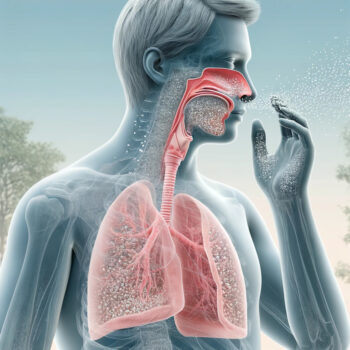Staff Writer for Wake Up World
A new threat has surfaced in a world increasingly concerned with environmental pollution—one that infiltrates our very breath. Recent research from the University of Technology Sydney (UTS) has revealed the disturbing presence of nano and microplastic particles in the respiratory systems of humans and birds. This groundbreaking study, led by Dr. Suvash Saha, offers a sobering look at how these plastic particles travel through and settle within our respiratory systems.
The Invisible Menace: Nano and Microplastics
[pro_ad_display_adzone id=”110028″]
The UTS research team utilized advanced computational fluid-particle dynamics (CFPD) to simulate how various plastic particles behave once inhaled. The findings, published in the journal Environmental Advances, highlight “hotspots” where these particles accumulate, ranging from the nasal cavity and larynx to the deeper regions of the lungs. As Dr. Saha explains, “Plastic particle air pollution is now pervasive, and inhalation ranks as the second most likely pathway for human exposure.”
Types and Sources of Plastic Particles
Plastic particles can be categorized into two primary types:
- Intentionally Manufactured Particles include particles found in everyday products such as cosmetics, toothpaste, and personal care items.
- Secondary Particles are fragments from the degradation of larger plastic items like water bottles, food containers, and synthetic textiles.
“Extensive investigations have identified synthetic textiles as a principal source of indoor airborne plastic particles, while the outdoor environment presents a multitude of sources encompassing contaminated aerosols from the ocean to particles originating from wastewater treatment,” Dr. Saha noted.
The Journey Through the Respiratory System
The study found that the journey and deposition of plastic particles in the respiratory system depend significantly on the breathing rate and the particles’ size and shape.
Breathing Rate and Particle Deposition
“Faster breathing rates led to heightened deposition in the upper respiratory tract, particularly for larger microplastics,” Dr. Saha stated. In contrast, slower breathing rates allowed smaller nanoplastic particles to penetrate deeper into the lungs. This differentiation is crucial for understanding the health impacts of these particles.
The Role of Particle Shape
Another critical factor identified was the shape of the particles. Unlike their spherical counterparts, non-spherical microplastic particles have a greater propensity for deeper lung penetration. This could lead to different and potentially more severe health outcomes. “Particle shape was another factor, with non-spherical microplastic particles showing a propensity for deeper lung penetration compared to spherical microplastics and nanoplastics,” said Dr. Saha.
Health Implications and the Path Forward
The health implications of inhaled plastic particles are profound. Dr. Saha’s study highlights how these particles can exacerbate a range of respiratory conditions, including chronic obstructive pulmonary disease (COPD), fibrosis, dyspnea (shortness of breath), asthma, and the formation of frosted glass nodules in the lungs. “Experimental evidence has strongly suggested that these plastic particles amplify human susceptibility to a spectrum of lung disorders,” Dr. Saha emphasized.
Mitigating the Risks
Understanding the behavior of these particles within our respiratory systems is essential for developing targeted strategies to mitigate their risks. Dr. Saha’s research underscores the importance of considering breathing rates and particle sizes in health risk assessments related to respiratory exposure to nano and microplastic particles.
Practical Steps to Reduce Exposure to Inhaled Plastic Particles
1. Improve Indoor Air Quality
- Use Air Purifiers: Invest in a high-quality air purifier with a HEPA filter to capture airborne particles, including microplastics.
- Ventilation: To reduce indoor particle concentration, ensure good ventilation in your home by opening windows and using exhaust fans.
2. Reduce Plastic Use
- Avoid Synthetic Textiles: Opt for natural fibers like cotton, wool, or linen instead of synthetic materials like polyester and nylon.
- Choose Plastic-Free Products: Select personal care and household products that are free from microplastics.
3. Clean Regularly
- Dust and Vacuum: Regularly dust surfaces and vacuum floors with a vacuum cleaner equipped with a HEPA filter to minimize the accumulation of plastic particles.
4. Monitor Breathing Environment
- Outdoor Activities: Be mindful of air quality when engaging in outdoor activities. Avoid exercising near busy roads or industrial areas where plastic pollution might be higher.
- Use Masks: In high-pollution areas, consider wearing a mask designed to filter out fine particles.
5. Advocate and Educate
- Raise Awareness: Share information about the risks of plastic particle pollution with your community.
- Support Legislation: Advocate for policies that reduce plastic production and promote the development of sustainable alternatives.
By incorporating these practical steps into your daily routine, you can help reduce your exposure to harmful plastic particles and contribute to a healthier environment.
Conclusion
The pervasive nature of plastic pollution now extends to the air we breathe, posing a hidden threat to our respiratory health. Studies like the one conducted by UTS are crucial as we continue to uncover the extent of this pollution. They provide the insights needed to develop effective interventions and protect our health from these invisible invaders.
Journal Reference:
- Xinlei Huang, Suvash C. Saha, Goutam Saha, Isabella Francis, Zhen Luo. Transport and deposition of microplastics and nanoplastics in the human respiratory tract. Environmental Advances, 2024; 16: 100525 DOI: 10.1016/j.envadv.2024.100525
About the author:
John Patterson is an avid writer and researcher who delves into the latest scientific research. With an insatiable curiosity, he translates complex concepts into accessible narratives, allowing readers to embark on a journey of discovery. John bridges the gap between experts and the public through his work, igniting curiosity and inspiring meaningful conversations about scientific breakthroughs.
[pro_ad_display_adzone id=”110027″]







